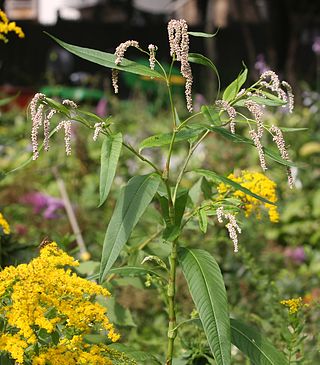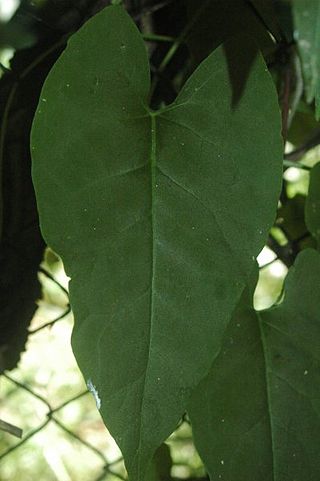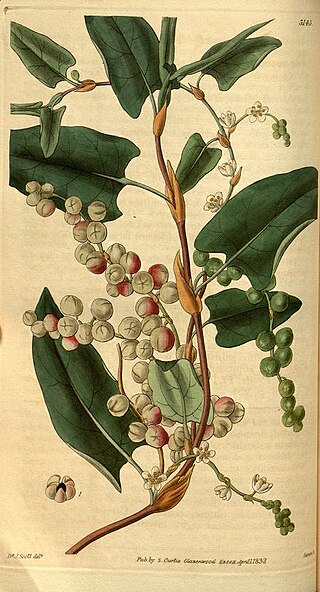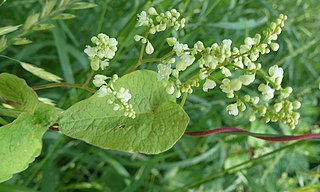
The Polygonaceae are a family of flowering plants known informally as the knotweed family or smartweed—buckwheat family in the United States. The name is based on the genus Polygonum, and was first used by Antoine Laurent de Jussieu in 1789 in his book, Genera Plantarum. The name may refer to the many swollen nodes the stems of some species have, being derived from Greek [poly meaning 'many' and gony meaning 'knee' or 'joint']. Alternatively, it may have a different origin, meaning 'many seeds'.

Polygonum is a genus of about 130 species of flowering plants in the buckwheat and knotweed family Polygonaceae. Common names include knotweed and knotgrass. In the Middle English glossary of herbs Alphita, it was known as ars-smerte. There have been various opinions about how broadly the genus should be defined. For example, buckwheat has sometimes been included in the genus as Polygonum fagopyrum. Former genera such as Polygonella have been subsumed into Polygonum; other genera have been split off.

Fallopia is a genus of about 12 species of flowering plants in the buckwheat family, often included in a wider treatment of the related genus Polygonum in the past, and previously including Reynoutria. The genus is native to temperate and subtropical regions of the Northern Hemisphere, but species have been introduced elsewhere. The genus includes species forming vines and shrubs.

Persicaria pensylvanica is a species of flowering plant in the buckwheat family, Polygonaceae. It is native to parts of North America, where it is widespread in Canada and the United States. It has also been noted as an introduced species in parts of Europe and South America. Common names include Pennsylvania smartweed and pinkweed.

Polygonum arenastrum, commonly known as equal-leaved knotgrass, is a summer annual flowering plant in the knotweed family Polygonaceae. Other common names include common knotweed, prostrate knotweed, mat grass, oval-leaf knotweed, stone grass, wiregrass, and door weed, as well as many others. It is native to Europe and can be found on other continents as an introduced species and a common noxious weed. Knotweed was first seen in North America in 1809 and is now seen across much of the United States and Canada.

Persicaria lapathifolia, known as pale persicaria, is a plant of the family Polygonaceae. It is considered to be native throughout most of the world, from arctic to tropical realms, except South America and Southern Africa. It is closely related to Persicaria maculosa and as such is considered a weed in Britain and Europe. Other common names for the plant include pale smartweed, curlytop knotweed, and willow weed. It is a species complex made up of a great many varying forms, sometimes considered varieties. The environment also has a strong influence on the morphology of an individual plant.

Reynoutria multiflora is a species of flowering plant in the buckwheat family Polygonaceae native to central and southern China. It is known by the English common names tuber fleeceflower and Chinese (climbing) knotweed. It is known as he shou wu (何首烏) in China and East Asia. Another name for the species is fo-ti, which is a misnomer.

Polygonum aviculare or common knotgrass is a plant related to buckwheat and dock. It is also called prostrate knotweed, birdweed, pigweed and lowgrass. It is an annual found in fields and wasteland, with white flowers from June to October. It is widespread across many countries in temperate regions, apparently native to Eurasia, naturalized in temperate parts of the Southern Hemisphere.

Galium boreale or northern bedstraw is a species of perennial flowering plant in the family Rubiaceae. It is widespread over the temperate and subarctic regions of Europe, Asia and North America including most of Canada and the northern United States.

Muehlenbeckia adpressa, commonly known as climbing lignum, is a prostrate or climbing plant, native to Australia. It has thin red-brown stems up to 1 metre in length. The leaves are 1.5–6 centimetres (0.59–2.36 in) long and 1.5–3.5 centimetres (0.59–1.38 in) wide. It occurs in coastal areas of Western Australia, South Australia, Tasmania, Victoria and New South Wales.

Hedysarum boreale is a species of flowering plant in the Fabaceae, or legume family, and is known by the common names Utah sweetvetch, boreal sweet-vetch, northern sweetvetch, and plains sweet-broom. It is native to North America, where it is widespread in northern and western regions of Canada and the United States. The ssp. mackenzii can even be found in the Canadian Arctic Archipelago.
Polygonum delopyrum, the fringed jointweed or hairy jointweed, is a plant species endemic to Florida. It is found in pinelands and sandy pine barrens at elevations less than 50 m, in central and southern parts of the state.
Polygonum agreste is a species of flowering plant in the family Polygonaceae, native to Uzbekistan. It was first described by Georgji Sumnevicz in 1940.
Polygonum heterophyllumSol. ex Meisn. is a species of flowering plant in the family Polygonaceae, native to Uzbekistan, Turkmenistan and Tajikistan. It was first described by Daniel Solander in 1856.
Polygonum exsertum is a species of flowering plant in the family Polygonaceae, native to Illinois. It was first described by John Kunkel Small in 1894.

Polygonum oxyspermum is a coastal species of flowering plant in the buckwheat family. It is native to Europe, primarily along the shores of the Atlantic, the North Sea, and the Baltic Sea, from France and Ireland to Finland and Russia. It is also naturalized in eastern Canada and in the US State of Maine.

Andersonglossum boreale, known as northern wild comfrey or just wild comfrey, is a species of flowering plant in the borage family, Boraginaceae. It is native to boreal coniferous and mixed forests in North America, from Nova Scotia to British Columbia and Yukon in Canada, south to New Jersey and Indiana in the United States. It is often found in rocky or sandy soils. It is extirpated from many of the southern parts of its range.

Polygonum ciliinode is a species of flowering plant in the family Polygonaceae, native to central and eastern Canada, and the north-central and eastern United States. The specific epithet is also spelt cilinode.

Symphyotrichum boreale is a species of flowering plant of the aster family (Asteraceae) native to North America. Commonly known as rush aster, northern bog aster, and slender white aster, it is a perennial, herbaceous plant that may reach heights of 85 centimetres.
Polygonum rurivagum is a species of flowering plant belonging to the family Polygonaceae.













